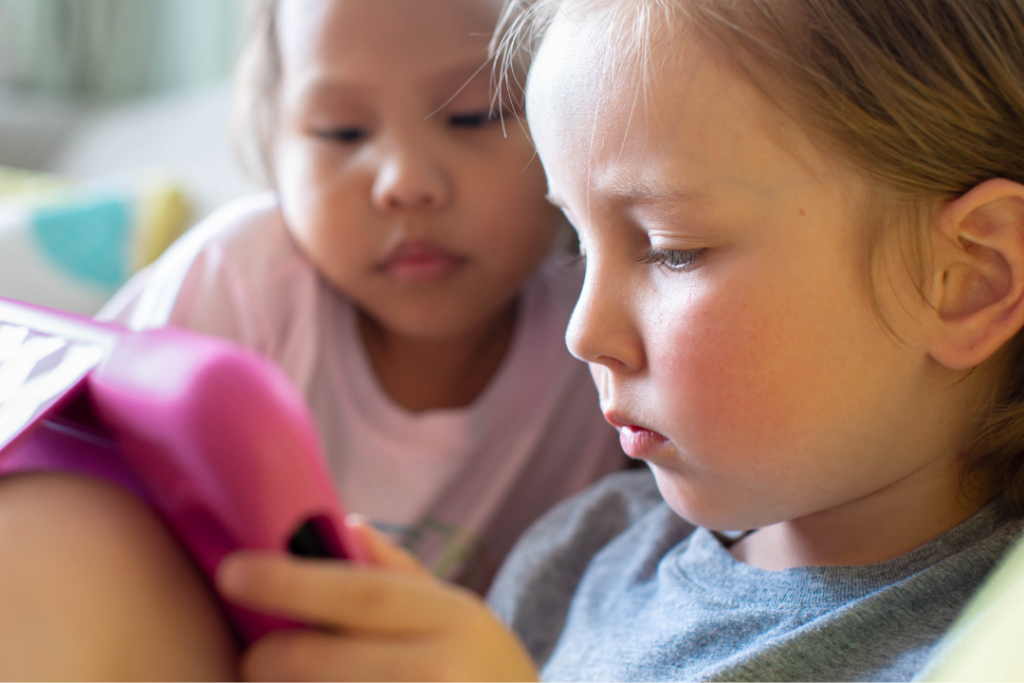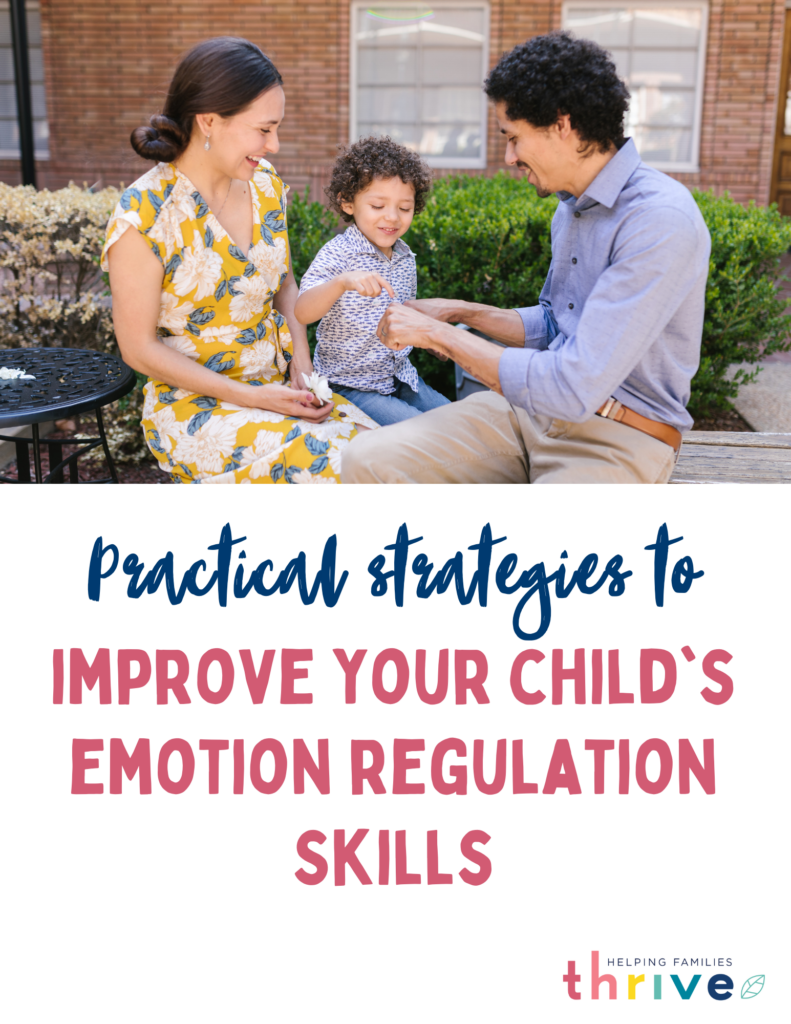
The headlines around screen time can be alarming, citing irreversible damage to your child’s brain and not-so-subtle insinuations that screens lead to ADHD. Much of the news coverage on screen time frames all screen time as bad. This just isn’t practical and it misses the nuance that new research is helping us understand. What a child is watching and when are essential to consider.
Before we get into it, we know as parents that screens can be a quick-fix tool to get 15 minutes for a shower, to finish an email, or even just to take a moment to breathe. That’s completely okay. As you read this, try to set any feelings of guilt aside. A few extra minutes of screen time here and there can give you much-needed breaks and is very unlikely to have a negative impact on your child.
What’s much more important to a child’s development than screens is having a warm, supportive relationship with you. If putting on an episode of Daniel Tiger helps you be more present and patient with your child later in the day, then the benefits outweigh the risks.
Still, if you’ve ever struggled to get your child to give back your smartphone (cue meltdown), then you know what a struggle screen time can be. We know many parents have questions about screens and children’s development, so let’s dive in.
How much screen time is okay?
Here are the screen time guidelines recommended by the American Academy of Pediatrics:
- Under 18 months: Avoid screen time, except for video chatting.
- 18 to 24 months: If you introduce screen time, watch it with your child and choose high quality educational content.
- 2 to 5 years: Limit screen time to one hour per day, focusing on high-quality programming.
- 6 years and up: Establish consistent limits on how much and what type of media your child is exposed to.
What’s high-quality educational programming?
Not all children’s media that’s marketed as “educational” is truly educational. This can make it tough for parents to know what programming is high quality. A few characteristics to look for include:
- Strong storylines that teach your child about emotions, relationships, or other everyday lessons that align with your values.
- Interactivity, like when a character asks your child a direct question and pauses so that they can respond.
- Content that allows your child to explore and deepen their interests.
- Slower pacing and fewer cuts from scene to scene can make it easier for your child to actually learn from screen time, according to research tracking where children look on the screen while watching educational media.
How does screen time impact children’s language development?
When it comes to language development and screen time, research tells us that it depends on the quality of what your child is watching and whether you’re co-viewing.
Children learn language best from real-time interactions because they get feedback from their listener. It’s a two-way conversation instead of them just being spoken to by a screen. High-quality educational content may be better at simulating this (for example, a television show that promotes interaction by leaving pauses for your child to respond). Additionally, if you co-view with your child and interact with them while you watch together, then that time spent together can promote language development (research suggests that this is especially true for boys!).
Background television has consistently been found in research to hinder language development. This is even more true for adult television, which makes sense; If you have something on in the background that you find engaging, you’re less likely to be engaging your child in a conversation.
What should parents take into account when it comes to screens and children with ADHD?
Research finds that children with Attention Deficit Hyperactivity Disorder (ADHD) spend more time with screens, on average, than neurotypical children. Many have interpreted this to mean that watching screens causes ADHD; however, it’s important to remember that correlation doesn’t equal causation. That is, just because X is related to Y doesn’t mean that X caused Y. Instead, when we find correlations, it should lead us to ask more questions about the nature of the relationship.
In fact, research suggests that kids with ADHD are exposed to more screens because their parents are more likely to use screens as a means of managing challenging behavior. Additionally, children with ADHD often are even more easily absorbed by screens than kids without ADHD. Different brains will respond differently to screen time; It’s not one size fits all.
Screen time should be limited for children with ADHD because they often need more support in developing skills that are best developed through real-life interactions. That time spent with screens replaces other activities that promote self regulation (playing board games, conversations, meal times, etc.). This is a valid concern about screens for all children, but especially for those who need extra support.
What do we know about screens and sleep?
A recent study shows that 1 in 3 children don’t get enough sleep. Screens, particularly at bedtime, are one culprit. Exposure to screens can disrupt sleep quality in part because of blue light. Screens emit artificial blue light which suppresses melatonin production, making it harder to fall asleep. Not all blue light is bad. The blue light the sun emits is essential for regulating your circadian rhythm, while a blue light from screens can disrupt it.
Screens right before bed aren’t great for anyone, but they can be especially problematic for kids. This is because children are even more sensitive to light than adults. Research has found that children’s melatonin is suppressed as much as twice as much as adults’ by exposure to light in the evening.
Screens can also indirectly affect sleep by taking the place of physical activity. When kids have time and space to move their bodies, it improves their sleep quality and duration.
How about parents’ own screen use?
Children learn by observing and imitating their parents, so it’s essential to reflect on our own screen habits. Being mindful of our own screen use not only sets a positive example for our children, but also allows us to be more present and engaged. For example, one study found that when parents are absorbed by their phones, they’re more likely to be impatient with their children and snap at them.
Practical tips for healthy screen habits:
- Set clear and consistent screen time limits based on your child’s age and developmental stage.
- Establish a consistent bedtime routine with calming activities like reading a book.
- Avoid screens for at least an hour before bedtime.
- Prioritize activities that allow your child to explore their offline interests and promote physical exercise, social interaction, and creativity.
- Explore educational and age-appropriate content together to make screen time more interactive and engaging. Shows like Bluey, Mister Rogers, and Daniel Tiger have slow-paced storylines that encourage social emotional skills.
- Encourage healthy tech habits, such as taking breaks and protecting personal information.
- Create screen-free zones and times, especially during meals, family outings, and before bedtime.
- Engage in open and ongoing conversations about screen time with your children, discussing its benefits and harms.
- Pay attention to how your child responds to screens. Remember different brains may respond differently, and you can adapt your rules and approaches based on your observations.
- If your child struggles with transitioning off of screen time, practice the transition before the screens turn on. This might sound like, “When the timer goes off in 30 minutes, dad will give you a two minute warning. When I say, “Time to turn it off and come play outside with us, you need fast listening ears and to turn it off right away. You can turn it off yourself or I can do it for you. I know you’ve got this.”
- If your child tends to get hyper focused on screens, be intentional about when screen time versus task demands are presented. For example, rather than having your child turn off the tv and then asking them to clean their room, reverse this to have a “first-then” approach. For example, “First pick up the dirty clothes on your floor and then you can have your screen time.” This will reduce potential power struggles behind the hard sell of stopping TV (super fun activity) to clean their room (not so fun).
Remember, our goal is to use what we know from science as a general compass to guide us on our parenting journey. Mix this in with your own values and knowledge of you family’s individual needs. For more research-backed parenting support, check out the variety of resources provided by Cooper and Helping Families Thrive.





